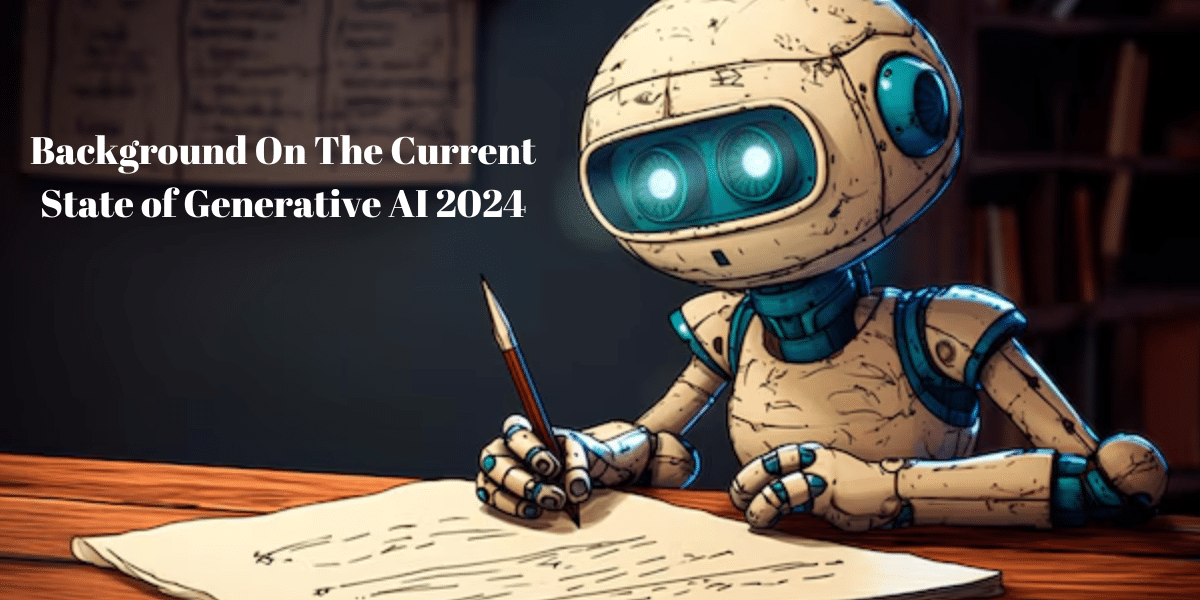It was a remarkable year! 2023 will forever be etched into history as the year when generative AI was first introduced, opening up revolutionary new technology possibilities daily! The names such as ChatGPT and DALL-E were widely acknowledged. Industries such as banking, healthcare, and high-tech have rapidly sought possibilities.
Before we knew that, artificially generated content was aplenty on the internet. Voice clones and deepfakes became popular, which raised ethical issues. Yes, challenges and worries will arise, but do they stop companies from looking at the benefits and effects that generative AI could offer? No!
However, an AI Development Company implementing a generative AI approach is complicated because it requires a deep knowledge of its possible application and potential limitations. Being aware of how different businesses operate will provide companies with valuable information.
According to a study conducted by 656 leaders in 8 significant sectors were surveyed to assess their current and anticipated use of generative AI. Review the positive uses and the business benefits up to now, and present solid, data-driven information about what is most crucial and the safeguards required to move to the next stage. Technologists and leisure people are getting acquainted with models for generating content, such as ChatGPT, which first came to light in 2022. This example of generative AI is only scratching the edge of what it could do and its direction.
Nearly 90% of enterprise AI executives have planned to implement generative AI (gen AI) for customer and internal use cases. About half of them, 47 percent, believe that productivity improvements are their primary objective. These anticipated benefits will be followed by more creativity (44 percent) and cost savings (41 percent).
Productivity improvements occur quicker than businesses can track because Shadow AI is growing faster than most IT and security departments expected. OpenAI states that its adoption by enterprises has been increasing rapidly, with more than 80 percent of Fortune 500 companies’ workers and departments already having accounts.
What Exactly Is Generative Artificial Intelligence ?
Generative AI can learn from the existing artworks and create authentic artifacts (at the scale) that reflect the properties of the original data. However, they do not duplicate it. Generative AI can develop unique content, including videos, images, songs, audio, text, and codes for software and product designs.
Generative AI employs a variety of strategies that keep evolving. Most important are AI-based models that can be trained using a wide array of unlabeled information, which are used to perform diverse tasks. Then, they can be further refined. A complex math equation and massive computing power are required to develop these model-based models, yet they’re, at their core, algorithms for prediction.
Nowadays, Generative AI Development Services most often creates material in response to natural language queries. It doesn’t need the knowledge or ability to enter code; however, the corporate uses encompass innovations in chip and drug design and material science development.
The Current State Of The Global AI Market
AI is an industry that is growing. Forecasts indicate an annual increase of 37.3 percent by 2030. This is mainly due to advances and the rising popularity of Generative AI technology and its possibilities, which have fascinated the entire world for several decades. For a long time, television and film have presented a world in which artificial intelligence is an integral part of our daily lives, with either a dark end (iRobot) or peaceful interdependence.
The world is closer than ever before to discovering how humans and AI can be able to live together. The research found the world’s artificial intelligence market is worth approximately USD 454.12 billion. The report showed that North America has the most significant part of the pie, with the AI market value reaching US$ 167.30 billion.
The AI market will continue to increase. The growth and rising utilization of Generative AI drives this increase in high-value, high-end investments. The rapid acceptance of Generative AI shows its ability to change how we perform our jobs, the capabilities we require, and the kind of work we’ll be doing.
What’s Driving The Recent Talk Regarding Generative AI?
We’ve been tracking generative AI via its hype Cycle(tm) of Artificial Intelligence since 2020 (also, the topic was included in our top Strategic Technology Trends in 2022). The technology is moving from its Innovation Trigger phase to the peak of Inflated Expectations. However, generative AI could only make the news in late 2022 by introducing ChatGPT, a chatbot capable of human-like interactions.
It is likely that as generative AI is a technology that can be used for all purposes, an impact comparable to that of the electric motor and steam engine as well as handiness. The excitement will fade when the actuality of its implementation begins to take hold. However, the significance of autonomous AI will increase as individuals and businesses discover new uses for this technology in everyday life.
Current State Of The Generative AI Landscape
Although generative AI technology is relatively modern, AI models meet many business and personal instances. Here are a few of the more popular AI instances in the current generative AI world today:
- Generative AI applications frequently utilize tools to generate textual content. Specific use examples are Q&A, travel and events planning, conversations, and even studies.
- AI-powered copilots and search engines have been gaining momentum rapidly. Several startups are also offering enterprise search solutions that use generative AI.
- Generative AI software for developers can anticipate the code sequence, help with problem-solving, create documentation for existing code, and even automate programming-related tasks.
- In addition to text, various Generative AI models can generate videos, audio, and images. The most recent developments in AI content creation include music, video games, and podcasts.
- Synthetic data generation and 3D model generation could be used to assist applications in computer vision, such as pedestrian monitoring, driver monitoring VR/AR/XR, virtual trial-on, and many more.
- AI-generated voice voices can be utilized in enterprise-level projects like marketing videos. AI voice capabilities are fast being made available in a broad selection of tones and languages.
- This and other examples are used in various sectors and departments in business, such as marketing and sales customers, contact centers, pharmaceuticals, and healthcare, including biophysics and biology entertainment, law and government finance and banking, and e-commerce.
Key Technologies Driving The Generative AI Landscape
Generative AI Development Services is developing rapidly for two significant reasons. More advanced neural network methods have come to fruition, and Computing power and models can now be accessed more easily. Google created the foundation of modern-day generative AI when it introduced an architecture for neural networks called Transformer in 2017. The Transformer made it feasible to develop better-quality language models that could be trained faster and with more customized features. Then, software that used predictive text and simple AI chatbots appeared and developed sporadically.
Yet, even after the advancement of transformers and related neural network architecture, the generative AI models still needed to be more affordable and more accessible to create and run. The processing of algorithms that generate AI queries demands power that most companies still need to possess.
The computing power and infrastructure layers of the AI platforms’ infrastructure increased the processing speed for advanced generative AI tools. This made it feasible for more businesses to create generative AI technology. In addition, this breakthrough allowed existing AI developers who were generative AI developers to develop their models for others for a low cost. At the same time, new techniques for neural networks, like diffusion models, also came into use to reduce the hurdles in the entry into the development of generative AI.
The advent of generative AI currently needs less effort and investment. The generative AI scene has grown to include established companies in the tech industry as well as innovative AI startup companies. The landscape constantly evolves since existing models are being extended to more users via APIs, limited versions, and open-source software, resulting in new software and new use cases being developed regularly.
Critical Trends In Generative AI
Look at some of the key statistics on artificial intelligence and patterns that define the views, applications, and impact on Generative AI.
Programming/Software Development Is Seeing The Most Impact On Productivity
AI tools can aid in faster query resolution. They can also give automated responses to commonly asked inquiries and provide immediate assistance to agents, which reduces response time and increases the volume of queries. AI tools can also assist with data analysis, content production, and automated formatting. They allow professionals to create a higher quantity of documents of high quality in less time.
When it comes to programming, this surge in productivity can be attributed to the ability of AI to perform routine tasks and recommend code improvement. It also provides assistance with debugging and allows programmers to concentrate on the more intricate and innovative programming elements.
Adoption Of Generative AI Is Explosive
ChatGPT is one of the fastest-growing applications for consumers ever. Marketing through word of mouth and a fantastic demonstration of the potential of Generative AI likely fueled such quick acceptance. This suggests we need devices to optimize our jobs by reducing the time and effort used elsewhere. There was no question of when we’d start to adopt AI. Instead, it was a question of when and what.
Generative AI Is Being Used To Fix Labor Shortages
According to a report, 25% of the surveyed companies have turned towards AI adoption to tackle problems with labor shortages. Companies adopting AI due to unemployment issues imply that AI is becoming more widely recognized as being able to fill the gaps that human workers leave. This could be the case in fields such as data processing, customer service (through chatbots), and other complicated tasks that require training and adaptation.
Businesses Believe In Generative AI’s Ability To Boost Productivity
The majority of firms believe that AI intelligence could boost their productivity overall. The belief that AI can improve productivity indicates that companies consider AI to increase productivity. This could mean automating routine processes, enhancing workflows, or offering insights that lead to more informed decisions. The data also indicates an answer to rapidly evolving market requirements, and companies must stay at the forefront of competition. AI adoption is critical to responding quickly to changes in market conditions and customer demands.
It is essential to ensure that human contributions and value don’t get lost in the shuffle of the business. Humanity can be our most distinctive asset, and companies should be cautious about transferring excessively fast to AI sidekicks.
Marketing And Sales Automation
Generative AI is often employed for sales, marketing, and other creative tasks, such as creating content at the present moment. Users can enter their requests for content into the generative AI models and chatbots; however, several AI providers are making it possible for customers to perform a minimum amount of prompting using the help of an AI companion or copilot to help automate tasks related to content creation.
Automation can automate the creation of blog and social media content, multichannel video and picture content, and outbound and inbound marketing workflows. Most of these programs are limited in terms of the languages they operate in and the context windows they can support. As the use case matures, you can anticipate seeing more multilingual applications with more context windows. This means that more significant and more intricate questions can be asked.
Embedded AI Applications
Some big tech companies now offer AI assistants that help users navigate experiences when searching on the internet and assist in creating content and task completion within the office suite, such as Microsoft 365. Google has likewise followed suit by launching Gemini, which has expanded capabilities to be utilized directly within Gmail, Docs, and others. Furthermore, some of the largest technologically advanced AI Development Companies offer AI-powered business tools for searching for customers.
As assistive enterprise tools expand their capabilities and features. Many businesses will adopt Microsoft’s model, as Google does, and integrate the applications on their sites, products, and internal programs to offer customers and employees the best experience.
Generative AI Landscape: Cybersecurity Implications
Generative AI instruments can simulate attacks and environments, such as threat intelligence and virtual l digital twins for synthetic sensitive information data. Although generative AI can provide these enhanced security measures and techniques when employed strategically, it is also susceptible to being altered by malicious actors and hackers who know the tricks and solutions to how AI models are developed and how data is utilized.
The number of artificial intelligence (AI) vendors is becoming generative. AI providers are improving their security approach with the available tools; however, they are all different. Many of these artificial AI products do not, or will not provide, all the security features needed for firms operating in highly regulated fields and dealing with sensitive information.
If you think the generative AI software has the proper cybersecurity safeguards to protect your company, it could lead to private or intellectual property theft. Moreover, there is a loss of trust from consumers and other compliance and legal concerns.
Future Directions Of The Generative AI Landscape
In line with current developments as well as the public’s desire in these areas, here are some of the regions in which we are expecting to see fresh potential and growth in the ever-changing AI environment:
Generative AI And Virtual Reality
Videos and 3D models are currently among the fastest-growing generative AI models. The growth in this area is noticeable in AI video content marketing that uses avatars, audio synthesizers, and various other dynamic AI capabilities to make captivating marketing material at an enormous scale. Games, marketing content, and entertainment and gaming media will benefit from this breakthrough in AI. Model-generated effects may cause virtual and augmented reality technologies — particularly those related to the metaverse — to produce unexpected side effects that people eagerly anticipate.
The models will be refined until the extent that they can handle more data, produce more high-quality media, and take longer windows for context. We can expect the generative AI technology to deliver real-time experiences that make virtual reality appear natural.
Shifting Career Paths And Opportunities
Generative AI instruments are currently supplementing certain kinds of work; in the future, they could replace specific jobs. However, this should not cause alarm for average professionals, provided they’re prepared to change their mindset and improve their abilities when job requirements evolve.
A good example is that many writers focus on SEO writing, which mainly involves creating well-ranked content in the search results. That’s precisely the kind of content AI models can create with algorithmic learning. Suppose a writer is concerned about workplace security when large-scale language models get stronger. In that case, it is essential to acquire new skills in strategic planning, including editorial planning.
The positive side is that these devices simplify repetitive tasks, including creating spreadsheets, sending emails, and recording action items and notes. These capabilities could be extended to more challenging jobs in the coming years. This includes brainstorming product launch plans or managing the HR onboarding process from the beginning through the process. As employees’ time is freed by these tasks that take up much of their attention, they’ll be able to concentrate on strategic tasks of more significant value often than previously.
Specialized Industry Apps And Tools
Although various industry-specific applications have been launched, specific sectors have a myriad of complexities and requirements for product releases that make it take time to launch these products rapidly. In the end, sure of these sectors are far further than others in AI use.
The AI healthcare industry can be a good instance. The healthcare industry is excited and energetic about generative AI; however, there has been significant churn and a need for more progress regarding the latest generative AI products. It could be due to a variety of factors. It’s safe to speculate that the heavily controlled PHI and PII information, along with the industry-specific patents (i.e., pharmaceutical patents) involved, makes it harder to leap through the required hoops.
Increased Regulation And Ethical Implications
AI usage still needs to be regulated in most industries and regions, leading to various issues. Certain users have suffered the consequences of their personal information getting incorporated into an AI model’s learning data and potential outputs. Other users are concerned about data storage and security procedures in these products. Certain AI companies have opted to improve their process of training and data collection techniques and make their overall approach more transparent. They need more on the part of regulatory institutions to enforce transparency.
Conclusion
Despite the ethical and legal concerns discussed earlier in this article, the future of Generative AI appears promising from an economic perspective. The application of AI will continue to grow as time passes by, with enhancements to the productivity of developers and new applications to help developers utilize AI to aid with software development and increase the capabilities and skills that companies employ to help.
Early adopters are already deploying the gen AI across various scenarios, from customer interaction to operations and product development. Early adopters are also testing Gen AI in multiple scenarios in customer engagement, operations, and the development of products.











